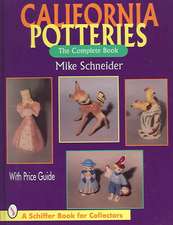Sotades: Symbols of Immortality on Greek Vases
Autor Herbert Hoffmannen Limba Engleză Hardback – 13 noi 1997
Preț: 1608.75 lei
Preț vechi: 2450.66 lei
-34% Nou
Puncte Express: 2413
Preț estimativ în valută:
307.83€ • 335.43$ • 259.40£
307.83€ • 335.43$ • 259.40£
Carte tipărită la comandă
Livrare economică 14-19 aprilie
Preluare comenzi: 021 569.72.76
Specificații
ISBN-13: 9780198150619
ISBN-10: 019815061X
Pagini: 224
Ilustrații: black and white halftone and line illustrations throughout
Dimensiuni: 196 x 256 x 19 mm
Greutate: 0.63 kg
Editura: OUP OXFORD
Colecția OUP Oxford
Locul publicării:Oxford, United Kingdom
ISBN-10: 019815061X
Pagini: 224
Ilustrații: black and white halftone and line illustrations throughout
Dimensiuni: 196 x 256 x 19 mm
Greutate: 0.63 kg
Editura: OUP OXFORD
Colecția OUP Oxford
Locul publicării:Oxford, United Kingdom
Recenzii
Some of the works of the potter Sotades, and of the Sotades Painter - notably the British Museum's white-ground cups - have become familiar. Others have not, and it is the great virtue of this well-illustrated book that it brings them together.
There is much food for thought in this book. Hoffmann evidently knows the relevant material as well as anyone alive, and he has chosen a splendid subject.
...'as exceptional and remarkable as the objects with which it deals...'
'...This challenging and unconventional study-published by the Oxford Univeristy Press, as were the standard volumes on Attic vase painters by Sir John Beazley - will substantially provoke and stimulate discussion of Greek, and especially Sotadean, vases, which are some of Classicl AThens' most fascinating and unclassical remains.'
The big-heartedness of Hoffmann's enterprise remains impressive ... Hoffmann's enthusiasm here strikes me every bit as infectious as it was 10 years ago; and again it is cause for gratitude.
Hoffman believes that each replicated series, together with their variants, must be taken collectively, thereby representing the totality of Athenian concerns about life, strife, and death for the individual citizen and for the Athenian polity as a whole - a persuasive view, skillfully presented.
Hoffmann's approach to interpreting vases, considering all the decoration on a given vessel in relation to its shape and carefully examining each detail, is to be applauded, and his innovative interpretations are often thought-provoking
Hoffman has an impressive grasp of a formidable range of evidence related to his subject, and has built up a complex and interesting series of interpretations. The footnotes in particular testify to a readiness to include evidence from all areas of the ancient world, not solely from art and archeology ... Hoffman has some fascinating insights, and has certainly thrown open some new areas for study; the book is full of possibilities. Although one may not be convinced by all his conclusion, the process by which he reaches them is always interesting.
There is much food for thought in this book. Hoffmann evidently knows the relevant material as well as anyone alive, and he has chosen a splendid subject.
...'as exceptional and remarkable as the objects with which it deals...'
'...This challenging and unconventional study-published by the Oxford Univeristy Press, as were the standard volumes on Attic vase painters by Sir John Beazley - will substantially provoke and stimulate discussion of Greek, and especially Sotadean, vases, which are some of Classicl AThens' most fascinating and unclassical remains.'
The big-heartedness of Hoffmann's enterprise remains impressive ... Hoffmann's enthusiasm here strikes me every bit as infectious as it was 10 years ago; and again it is cause for gratitude.
Hoffman believes that each replicated series, together with their variants, must be taken collectively, thereby representing the totality of Athenian concerns about life, strife, and death for the individual citizen and for the Athenian polity as a whole - a persuasive view, skillfully presented.
Hoffmann's approach to interpreting vases, considering all the decoration on a given vessel in relation to its shape and carefully examining each detail, is to be applauded, and his innovative interpretations are often thought-provoking
Hoffman has an impressive grasp of a formidable range of evidence related to his subject, and has built up a complex and interesting series of interpretations. The footnotes in particular testify to a readiness to include evidence from all areas of the ancient world, not solely from art and archeology ... Hoffman has some fascinating insights, and has certainly thrown open some new areas for study; the book is full of possibilities. Although one may not be convinced by all his conclusion, the process by which he reaches them is always interesting.






